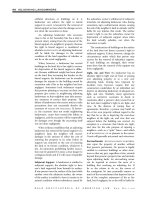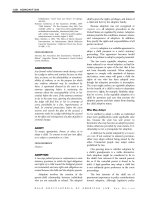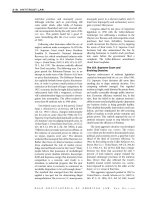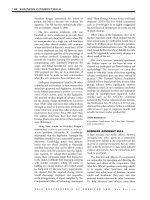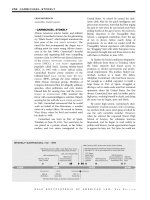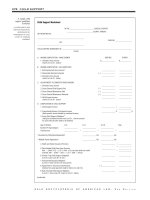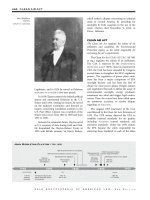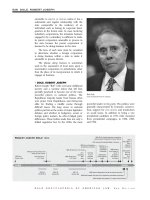Gale Encyclopedia Of American Law 3Rd Edition Volume 3 P44 potx
Bạn đang xem bản rút gọn của tài liệu. Xem và tải ngay bản đầy đủ của tài liệu tại đây (230.66 KB, 10 trang )
allowing the government to be shut down for a
long period rather than give in to Republican
spending cuts.
The
IMPEACHMENT trial of Clinton in 1999
furthered the partisan divide in the country. Led
by a Republican Congress, the impeachment
process was backed by a majority of Repub-
licans and opposed by a majority of Democrats.
Despite the embarrassment to Clinton, the
LEGAL
PROCEEDINGS
did not seem to hurt the Democrats
in the same way WATERGATE hurt the Repub-
licans. The Democrats actually picked up seats
in the House and the Senate in both the 1998
and 2000 elections.
Just how evenly the country was split
between the Republicans and Democrats was
illustrated by the 2000 election. Democratic
presidential candidate
AL GORE won the popular
vote by over 500,000 votes; however, the
Electoral College was another story. A disputed
ballot count in Florida kept the election from
being officially decided for more than a month
after election day. When it was over,
GEORGE W.
BUSH had become PRESIDENT OF THE UNITED STATES
by a mere 537 votes, according to the Florida
statewide official tally. Bush beat Al Gore in the
Electoral College 271 to 266, one of the closest
results in U.S. history.
Ironically, considering that they won the
popular vote for president and picked up seats
in both the House and Senate, the 2000 election
paradoxically lef t the Democrats in their
weakest position since the Eisenhower admin-
istration. In addition to the presidency, the
Republicans controlled the House and the
Senate by slim majorities. In the Senate, that
majority consisted of one seat.
However, the decision by Senator Jim
Jeffords (R-Vt.) to become an independent in
2001 gave the Senate majority to the Democrats
for the first time since 1994. Using their majority,
the Democrats were able to frustrate President
Bush on some of his proposed policies, though
they were too weak to pass legislation on their
own. The Republicans strengthened their posi-
tion after the 2002 election, regaining control of
the Senate and increasing the number of seats
they controlled in the House. But they still did
not have enough votes to stop a Democratic
FILIBUSTER in the Senate, thus giving the Demo-
crats a measure of power.
Some party activists felt at the end of the
2002 campaign that the Democratic Party had
lost its way with the centrist policies advocated
by former president Clinton and others; they
saw the way back to power to take the party in
a more liberal direction and to delineate more
strongly their differences with Republicans.
Others saw this as political suicide, pointing out
that Clinton was the only successful Democratic
candidate in the past quarter century.
The Democratic nominee in the 2004
presidential election was Senator John Kerry
(D-Mass.). He ran against George W. Bush,
who sought a second term in the Oval Office.
Bush was re-elected as president, winning in the
Electoral College 286 to 251 and earning nearly
51 percent of the popular vote. Democrats
critical of Kerry lamented about what they had
perceived as a slow-moving and unf ocused
campaign by a stiff candidate. In the wake of
the election, Democrats with centrist positions
urged against the party swinging more to the left
as an answer to the political defeat.
The 2006 mid-term elections began a period
of positive change for the Democratic Party.
Amid scandals tainting several Republican can-
didates seeking re-election and an increasingly
unpopular war in Iraq, Democratic candidates
won control of both houses of Congress, and a
majority of governorships and state legislatures.
The shift in power to Democrats was made
historically significant by giving rise to the first
woman Speaker of the House of Representa-
tives, Nancy Pelosi.
BARACK OBAMA was the Democratic nominee
in the 2008 presidential election. Obama was
considered a relative newcomer in Washington,
D.C., and a mainstream Democrat on nearly all
issues. Obama first began serving in the Senate
in 2005 and officially launched his campaign
for president in 2007. His campaign focused on
bringing change to the United States by ending
the unpopular war in Iraq, conserving energy
and reforming the healthcare system. He defeated
Republican nominee
JOHN MCCAIN 365 to 173 in
the Electoral College and earned 53 percent of
the popular vote. He is the first African
American and biracial president in the history
of the United States.
FURTHER READINGS
Judis, John B., and Ruy Teixeira. 2002 The Emerging
Democratic Majority. New York: Scribner.
Miller, Senator Zell. 2003 A National Party No More: The
Conscience of a Conservative Democrat. Macon, Ga.:
Stroud & Hall Publishers.
GALE ENCYCLOPEDIA OF AMERICAN LAW, 3RD E DITION
418 DEMOCRATIC PARTY
Stanley, Timothy. 2010. Kennedy vs. Carter: the 1980 Battle
for the Democratic Party’s Soul. Lawrence: University of
Kansas Press.
Wagner, Heather Lehr. 2007. The History of the Democratic
Party. New York: Chelsea House Publications.
Wilson, James Q., and John J. Dilulio Jr., and Meena Bose.
2010. American Government: Institutions and Policies.
12th ed. Boston: Cengage Learning.
CROSS REFERENCES
Elections; Republican Party.
DEMONSTRATIVE EVIDENCE
Evidence other than testimony that is presented
during the course of a civil or criminal trial.
Demonstrative evidence includes actual evidence
(e.g., a set of bloody gloves from a murder scene) and
illustrative evidence (e.g., photographs and charts).
Many trial attorneys view the presentation
of evidence to the jury as analogous to the
presentation of information by a teach er to
students. As in the classroom, the involvement
of more than one of a juror’s senses in the
courtroom increases the amount of information
retained by that juror. For example, combining
verbal testimony from
WITNESSES with before and
after X rays, or introducing a defective machine
part that jurors can hold in their hands for
inspection, makes for compelling courtroo m
activity. In a modern, “show-me” society, the
ability of a trial lawyer to use demonstrative
evidence effectively can make the difference
between winning and losing a case .
One common and effective example of
demonstrative evidence is the still photograph.
Photographs of a plaintiff’sbruisestakenimme-
diately after an accident can help a jury under-
stand those injuries in a trial that occurs months
or even years after the accident, when the
injuries may have healed. Aerial photographs of
the scene of a vehicular accident can show how
a particular intersection is laid out, and can
make more clear an ambiguous description of
a blind intersection given by a witness.
X rays and medical models and illustrations
can be very helpful to a jury in physical injury
cases. These examples of demonstrative evi-
dence help the jury “see inside” the victim to
understand the nature and extent of the injuries.
X rays can show not only fractures but also
permanent metal pins and plates. Accurate
models of a plaintiff’s head and neck can show
the interaction between the cervical area of the
spine and the surrounding muscle and tissues in
a soft-tissue injury case. Sometimes, partial or
full skeletons are brought into courtrooms to
demonstrate losses or restrictions of movement
due to injuries. Modern computer-generated
illustrations can show the exact injury to a
specific
PLAINTIFF, as opposed to the generic injury
represented in a stock medical illustration.
Graphs and charts are perhaps the most
useful forms of demonstrative evidence. These
tools can vividly illustrate a loss of earnings, a
decrease in life expectancy, and past and future
medical bills. Clear and concise charts can help
a jury to arrange a complex set of events in a
chronological fashion. These time lines can be
crucial in organizing evidence, whether in a
criminal trial or in a complex securities litigation.
Often, maps and other geographic charts are
used to show water flow, elevation, and other
physical characteristics of real property (land).
Graphs and charts can be presented to a jury
in a variety of ways. In addition to offering the
standard large prepared poster board on an
easel, some attorneys prefer to create charts as
they speak to the jury, using large blank pieces
of poster board and colored marker pens.
Other attorneys like the dramatic effect of
dimming the courtroom lights and using an
overhead projector or computer screen to focus
visual attention on their illuminated charts
and graphs. Whatever the style of presentation,
well-constructed charts and graphs that make
good use of color and are clear and easy to
understand are appreciated by jurors and can
have a big effect during deliberations.
Articles and objects are also forms of demon-
strative evidence. In addition to actual evidence
that is introduced at trial (like the knife from a
MURDER scene), other physical articles and objects
A common and
effective type of
demonstrative
evidence is the still
photograph. In this
example, a police
technician points to
an area on an interior
photograph of a
defendant’s home
where fiber evidence
(actual evidence)
submitted in a San
Diego, California,
murder trial was
discovered.
AP IMAGES
GALE ENCYCLOPEDIA OF AMERICAN LAW, 3
RD E DITION
DEMONSTRATIVE EVIDENCE 419
can be used to help the jury understand the
testimony. For example, in a PRODUCT LIABILITY
action based on a defective artificial hip, giving
the jury models of ball-and-socket joints to
manipulate and examine with their own hands
can clarify testimony regarding the replacement
joint that is still inside the plaintiff. Three-
dimensional models and mock-ups of roadways,
accident sites, or proposed buildings can simulate
the outside world inside the courtroom to give
proportion and scale to a witness’stestimony.
With the permission of the judge, attorneys
may be allowed to take the jurors to the scene of
the crime or accident. Here, all of a juror’s
senses are at work, and testimony presented in
court can be compared to and contrasted with
the physical scene. A list prepared by both
attorneys of items to “notice” ma y be read by
the
BAILIFF at the scene. Many juries appreciate
not only the chance to get outside the
courtroom but also the opportunity to see for
themselves the place where it all happened.
With the advent of low-cost videocassette
players and recorders, it has become more and
more common to see videotape in the court-
room. A “day in the life of …” video can
graphically demonstrate the activities of a
plaintiff living with debilitating injuries. For
example, a plaintiff witness may say, “Ican’tpick
up my children,” whereas a video can actually
show the plaintiff’s young children milling about
with the plaintiff able only to sit by and watch
them. Videotapes can also show the traffic volume
at a busy intersection or provide a driver’s-eye
view of a road sign obstructed by brush and
leaves. If a jury is unable to leave the courtroom
to visit the scene of a fire, a video camera can
provide a tour through the burned-out remains
of the family’s residence. Some attorneys have
begun hiring stuntpersons to re-create vehicular
accidents, drivi ng comparable vehicles at the
speeds they were going when the accidents
occurred, and filming the results. Unlike a
controlled dramatic re-creation, this kind of
actual re-creation, with its inherent danger yet
accurate representation of accident conditions,
can be an effective tool at trial.
Though waning in popularity owing to the
greater availability and lower cost of computers,
slide projectors and human-created animation
are still used by some attorneys. By taking two
slide projectors, superimposing their projec-
tions, and connecting them with a sophisticated
mechanical device, an attorney can make a before
picture fade into an after picture with dramatic
results. As with a presentation using an overhead
projector, the dark courtroom and brightly-lit
screen of a slide presentation focus the jury’s
visual attention. Animated cartoon shorts, hand
inked by artists, are eye-catching and can portray
exactly what the attorney wants to emphasize
to the jury: For example, a cutaway “operating”
engine might show how a defective part can
cause the engine to break down.
Computers and computer-generated dis-
plays are at the cutting edge of demonstrative
evidence. Computer-enhanced graphics can
demonstrate anything from the speed of a vehicle
to the loss of range of motion on an injured
portion of the body. Computers also provide
high storage capacity. One CD-ROM disc can
store thousands of still photos, graphs, charts,
digitized video clips, and even three-dimensional
computer animations. An attorney who uses a
computer to coordinate a presentation can com-
bine many different forms of demonstrative
evidence into a cohesive and dramatic whole.
Still photos of an injury might be followed
by a digitized video showing limited physical
abilities after the injury. X-ray images can fade
into graphs showing a loss of earning capacity.
All these exhibits can be stored in a laptop
computer and presented with minimal setup
and distraction to the jurors. And the attorney
making the presentation can instantly return
to a particular demonstrative exhibit when mak-
ing a point during closing argum ents.
Another significant development in court-
room technology is the use of bar codes. This
technology is helpful in organizing evidence in
cases with numerous exhibits. Bar codes function
in court much as they do in the department or
grocery store. Exhibits, be they photographs or
documents, are stored on CD-ROM according to
bar code. By entering or scanning the number,
the item is immediately retrieved and can be
displayed on the computer screen.
Many newer courtrooms are equipped with
individual computer terminals, so that jurors
may view computer displays by attorneys on
individual screens in the jury box. A future
development may be the use of virtual reality—
where individuals see and hear computer-
generated images and sounds, and through
body sensors “see” their hands and body within
the simulation.
GALE ENCYCLOPEDIA OF AMERICAN LAW, 3RD E DITION
420 DEMONSTRATIVE EVIDENCE
No matter the technology, demonstrative
evidence must still conform to standard eviden-
tiary rules. The trial court may disallow any item
of demonstrative evidence that is inaccurate or
incomplete. Courts can also strike evidence if
it is unnecessarily cumulative: For example, 30
photographs of one bruise that can be seen
clearly in one or two photographs constitute
evidence that is unnecessarily cumulative.
An attorney must keep in mind that demon-
strative evidence is not
REAL EVIDENCE:Itmerely
illustrates the points being argued to the jury
and court. Computer-generated animation
may only portray evidence that has been pro-
perly presented to the jury through testimony or
as physical evidence. A chart or graph may only
present numbers and amounts that have been
properly calculated and proved. No matter how
exciting the “show,” the attorney must remem-
ber that items of demonstrative evidence are
merely props, and that the witnesse s and their
testimony are still the primary method of
presenting evidence to a jury.
FURTHER READINGS
Brain, Robert D., and Daniel J. Broderick. 1992. “The
Derivative Relevance of Demonstrative Evidence:
Charting Its Proper Evidentiary Status.” Univ. of
California at Davis Law Review 25.
Branson, Frank L. 1986. Demonstrative Evidence. New York:
McGraw-Hill.
Heffernan, Thomas A. 1987. “Effective Use of Demonstra-
tive Evidence—‘Seeing Is Believing.’” American Journal
of Trial Advocacy 5.
Lilly, Graham C. 1996. An Introduction to the Law of Evidence.
3ded.Eagan,Minn.:West.
Mauet, Thomas A., and Warren D. Wolfson. 2009. Trial
Evidence. 4th ed. Frederick, Md.: Wolters Kluwer Law &
Business.
O’Callaghan, Richard M. 1988. “Introduction and Use of
Demonstrative Evidence.” Practising Law Institute/
Litigation 360 (October 1).
Reuben, Richard. 1995. “Stuntpersons Add Drama to
Cases.” American Bar Association Journal (November).
Taub, Theodore C. “Demonstrative Evidence.” American Law
Institute-American Bar Association C432 (August 14).
DEMONSTRATIVE LEGACY
A gift by will of money or other personal property
that is to be paid to an heir from a fund designated
in the provisions of the will but, in any event, is to
be paid if there are sufficient available assets in
the estate.
A demonstrative legacy differs from a
SPECIFIC
LEGACY
, a gift of particular PERSONAL PROPERTY by
will. A demonstrative legacy is payable from the
general assets of the estate that have not been
specifically devised or bequeathed if its desig-
nated source has been adeemed or no longer
exists or if it is inadequate to satisfy the gift. In
the case of a specific legacy the ademption of
property revokes the gift completely so that the
heir receives nothing. However, if the value of
the gift has only been reduced, the heir receives
the decreased value.
Courts often interpret provisions of a will
that appear to grant specific legacies of money
or shares of stock as demonstrative legacies to
avoid the consequences of ademption where it
is clear that the
TESTATOR intended the gift to
be made in any event.
DEMUR
To dispute a legal pleading or a statement of the
facts being alleged through the use of a demurrer.
DEMURRAGE
A separate freight charge, in addition to ordinary
shipping costs, which is imposed according to the
terms of a carriage contract upon the person
responsible for unreasonable delays in loading or
unloading cargo. In maritime law, demurrage is
the amount ident ified in a charter contract as
damages payable to a shipowner as compensation
for the detention of a ship beyond the time specified
by a charter party for l oading and unloading or
for sailing.
Demurrage is intended to serve the
PUBLIC
INTEREST
by facilitating the flow of commerce
through the prompt loading and unloading of
cargo. In general, the person liable for demur-
rage is the one who assumed the duty to unload
or load the cargo but failed to fulfill it. A
consignee who agrees to unload a shipment but
unreasonably delays in doing so is liable for the
charge.
Payment of demurrage is excused only if the
delay was unavoidable, such as a delay caused
by a natural disaster or the fault of the carrier.
Reciprocal demurrage may be imposed upon a
carrier who unreasonably delays in providing
transportation to customers. The practical effect
of reciprocal demurrage is a reduction in the
customer’s shipping charges unless the contrac-
tual amount exceeds that figure. If a person
against whom demurrage is imposed fails to
pay, the carrier might have a right to keep the
goods until payment is made. This is known as
GALE ENCYCLOPEDIA OF AMERICAN LAW, 3RD E DITION
DEMURRAGE 421
demurrage lien, enforceable only if authorized
by statute, contract, or custom.
CROSS REFERENCE
Shipping Law.
DEMURRER
An assertion by the defendant that although the
facts alleged by the plaintiff in the complaint may
be true, they do not entitle the plaintiff to prevail
in the lawsuit.
The pleadings of the parties to a lawsuit
describe the dispute to be resolved. The
PLAINTIFF
sets out the facts that support the claim made
in the complaint, and the
DEFENDANT then has
an opportunity to respond in an answer.
A demurrer is a type of answer used in
systems of
CODE PLEADING, established by statute
to replace the earlier common-law FORMS OF
ACTION
. Whereas a demurrer admits the truth of
the plaintiff’s set of facts, it contends that those
facts are insufficient to grant the complaint in
favor of the plaintiff. A demurrer may further
contend that the complaint does not set forth
enough facts to justify legal relief or it may
introduce additional facts that defeat the legal
effectiveness of the plaintiff’s complaint. A
demurrer asserts that, even if the plaintiff’s
facts are correct, the defendant should not have
to answer them or proceed with the case.
Under the modern rules of pleading estab-
lished by the rules of federal
CIVIL PROCEDURE and
followed in a number of states, the demurrer
has been abolished as a formal type of answer.
The same argument against the plaintiff’s
CAUSE
OF ACTION
can be, however, made by motion to
dismiss the plaintiff’s action on the ground that
he or she has failed to state a claim on which
relief can be granted. Even where the formal
demurrer is no longer used, lawyers and judges
often use the old term for an argument of the
same type.
DENY
To refuse to acknowledge something; to disclaim
connection with or responsibility for an action or
statement. To deny someone of a legal right is to
deprive him or her of that right.
A denial is a part of a legal pleading that
refutes the facts set forth by the opposing side.
A general denial takes exception to all the
material elements of the complaint or petition,
and a specific denial addresses a particularalle-
gation in issue.
DEPARTMENT OF…
See specific department; e.g., EDUCATION DEPART-
MENT
.
DEPENDENT
A person whose support and maintenance is con-
tingent upon the aid of another. Conditional.
A dependent is someone w ho is sustained
by another person, such as a child supported by
his or her parents.
In an insurance policy, the term legal de-
pendent generally includes all of those people
whom the insured person is under a legal
duty to support, such as a spouse and minor
children. A lawful dependent includes someone
whom an insured perso n is permitted, but not
required, to support.
That which is dependent is conditional
upon the occurrence of another event. A depen-
dent contract is an agreement between two parties
that is conditional upon another agreement.
For example, one person agrees to deliver goods
to another person only after that person con-
tracts to purchase such goods from the first
person only for a certain designated period.
DEPENDENT RELATIVE REVOCATION
The doctrine that regards as mutually interrelated
the acts of a testator destroying a will and executing
a second will. In such cases, if the second will is
either never made or improperly executed, there is
a rebuttable presumption that the testator would
have preferred the former will to no will at all,
which allows the possibility of probate of the
destroyed will.
Some jurisdictions decline to apply the
doctrine of
DEPENDENT RELATIVE REVOCATION to
cases to eliminate a written revocation of a will,
but apply it t o decla re the ineffectiveness of
a physical act of revocation. The justification
for the distinction is that the physical act is
inherently equivocal. The court has the power
to interpret the ambiguous act to ascertain what
the
TESTATOR did but not to disregard an express
statement of the testator and substitute its own
conception of what the testator should have done.
The doctrine of dependen t relative revoca-
tion contravenes the strict interpretation of and
GALE ENCYCLOPEDIA OF AMERICAN LAW, 3RD E DITION
422 DEMURRER
demand for rigid adherence to the specific
language of the statutes conce rning the execu-
tion and revocation of wills and the theory of
the
PAROL EVIDENCE rule. In deciding whether to
apply the doctrine, the court considers the
TESTAMENTARY pattern of the decedent, the terms
of the prior wills, the respective identities and
shares of the beneficiaries under the previous
will and the new will in question, the nature of
the defect that prevents the new will from taking
effect, the trustworthiness of the proof of the
reasons for the testator’s desire to make the
desired objective to the former testamentary
plans as contrasted to the application of the laws
of
DESCENT AND DISTRIBUTION. The court will not
execute a new will, but it will eradicate revoca-
tions to infuse new life into a prior will that
achieves the same objective.
DEPENDENT STATES
States can be classified into two general catego-
ries: dependent and independent. A dependent
state does not exercise the full range of power
over external affairs that an independent state
possesses under
INTERNATIONAL LAW. The control-
ling or protecting state may also regulate some of
the internal affairs of the dependent state. Formal
treaties and the conditions under which the status
of dependency has been recognized by other
states govern the balance of sovereign powers
exercised by the protecting state and the depen-
dent state. Various terms have been used to
describe different types of
DEPENDENT STATES, such
as condominium, mandate,
PROTECTORATE, and
vassal state. Since 1945 there has been strong
international pressure to eliminate forms of
dependency associated with colonialism.
DEPLETION ALLOWANCE
A tax deduction authorized by federal law for the
exhaustion of oil and gas wells, mines, timber, mineral
deposits or reserves, and other natural deposits.
Frequently, the ownership of such resources
is split so that the depletion deduction is allotted
among the various owners. Rights to royalty
payments, leases, and subleases are not the
same as ownership but the holders of such rights
may be entitled to depletion deductions under
the theory of “economic interest” formulated by
the courts to ascertain the right to depletion
allowances. Such economic interest, which
signifies an investment interest in the minerals
that furnish the sole resource for recouping the
investment, is usually determined by the parties
according to the provisions of their contract.
The cost method and the percentage, or
statutory, method represent the two ways of
calculating the
DEPLETION ALLOWANCE.
Cost depletion, like depreciation, bases the
allowance on the original cost of the income-
generating property. For example, a taxpayer
who purchases rights to extricate oil for $2
million should be permitted to regain the
capital tax-free when he or she extracts and
markets the oil. The earnings from the deplet-
able property should be viewed as encompass-
ing a return of the taxpayer’s capital investment.
A proportionate segment of such receipts
each year should be exempt from
TAXATION as
income. When oil is viewed as a “wasting asset,”
cost depletion permits yearly deductions for
the receipt of $2 million tax-free over the
duration of the pumping operations. The tax
law permits the taxpayer to divide the cost of
the investment by the estimated total of
recoverable units in the natural deposit. This
cost per unit is subsequently multiplied by the
number of units sold annually, which results in
the depletion deduction permitted for that year.
The percentage, or statutory, method does
not employ recovery of cost in the computa-
tion of the deduction. A percentage of annual
income, rather than cost, is deductible each
year, even if the owner has recovered all cost or
discovery value of the depletable asset. The
federal tax laws vary from year to year in regard
to the percentage depletion allowable for oil
and some other deposits, and the categories of
producers entitled to such allowances.
Federal law allows the
owners of mining
operations, such as
this copper mine in
southeastern
Arizonia, to claim a
tax deduction upon
the depletion of the
mine’s natural
deposits.
AP IMAGES
GALE ENCYCLOPEDIA OF AMERICAN LAW, 3
RD E DITION
DEPLETION ALLOWANCE 423
Percentage depletion, which applies to other
mineral deposits or energy sources such as
geothermal steam, provides an extremely profit-
able allowance as an alternative to cost depletion.
The taxpayer calculates a fixed percentage of his
or her gross income and deducts that amount
from gross income annually for as long as the
property generates income, even after he or she
has completely recovered the actual cost. Some
taxpayers employ cost depletion at the outset of
operations, when a large number of units of the
deposit are extracted and sold, and then convert
to percentage depletion upon
RECOUPMENT of cost
in other circumstances—when percentage deple-
tion yields a more sizable deduction.
Percentage depletion furnishes an additional
tax subsidy to detection, development, and dissi-
pation of qualified reserves. The subsidy approach
began during
WORLD WAR I t o induce exploration for
minerals. Cost depletion ha d been expanded to
permit discovery value rather tha n cost to serve a s
the ga uge of tax-exempt recovery. A problem in
estimating the quantity of depletable units prior to
extraction ex isted, how ever, a nd p ercentage deple-
tion was en acted in 1924 as the solution. This
method w a s sub-sequently extended t o include
additional minerals and other deposits and to
raiseratesofdepletioninsomeinstances.Itwas
eventually diminished due to excessive profits and
tax b enefits obtained by some companies. Only
depletion, rather than percentage depletio n, may
be used for gas, water, soil, t imber, and oil.
For percentage depletion, gross income must
be restricted to income from extracting and selling
the deposit, not from refining, processing, or
manufacturing it.
The option to deduct present ex ploration and
development expenditures rather than capitalizing
them represents an additional tax advantage for the
industries ent itled to depletion all owances. A more
substantial tax benefit ensues if such expenses
are d educted immediately, since they would never
be recovered through the application of percentage
depletion, which is based on gross income and not
the cost of t he capital invested in the enterprise.
CROSS REFERENCES
Income Tax; Mine and Mineral Law.
DEPONENT
An individual who, under oath or affirmation,
gives out-of-court testimony in a deposition . A
deponent is someone who gives evidence or acts as
a witness. The testimony of a deponent is written
and carries the deponent’s signature.
DEPORTATION
Banishment to a foreign country, attended with
confiscation of property and deprivation of
CIVIL
RIGHTS
.
The transfer of an alien, by exclusion or
expulsion, from the United States to a foreign
country. The removal or sending back of an alien
to the country from which he or she came because
his or her presence is deemed inconsistent with the
public welfare, and without any punishment being
imposed or contemplated. The grounds for depor-
tation are set forth at 8 U.S.C.A. § 1251, and the
procedures are provided for in §§ 1252–1254.
To further clarify deportation, the U.S. Su-
preme Court, in Zadvydas v Davis, 533 U.S. 678,
121 S.Ct.2491, 150 L.Ed.2d 653 (2001), r uled that
ALIENS who are under investigat ion ca nnot be held
indefinitely. This would be in violation o f the Due
Process Clause of the
FIFTH AMENDMENT of the
federal Constitution. Moreover, the Court e stab-
lished a maximum six-mont h detention period. At
thatpointthealienmustprovideinformationasto
why removal to the c ountry of origin is not likely
in the foreseeable future. For example, in this case,
Kestutis Zadvydas was born to Lithuanian parents
who were held in a Germa n displaced persons
camp; both Lithua nia and Germany refused to
accept him into their countries because he was
not a citizen. If the government cannot
REBUT this
information, the alien must be released from
confinement. Finally, the Court declared that the
federal c ourts are the proper place to review issues
of deportation, rejecting the government’sclaim
that
IMMIGRATION is strictly the province o f t he
executive branch.
Following the September 11, 2001, terrorist
attacks on the United States, Congress created
the USA PATRIOT Act, Pub.L. No. 107-56, 115
Stat. 272 (2001). The law deals with various
means of combat ing
TERRORISM and includes
provisions that authorize the deportation of
individuals who provide lawful assistance to any
group that provides assistance to terrorists.
Accused persons must convince the governmen t
that they did not know their contributions were
being used for terrorist activities.
FURTHER READINGS
Cole, David, and Jack X. Dempsey. 2006. Terrorism and the
Constitution: Sacrificing Civil Liberties in the Name of
National Security. New York: New Press.
GALE ENCYCLOPEDIA OF AMERICAN LAW, 3RD E DITION
424 DEPONENT
“Deportation from the United States.” 2009. U.S. Immigra-
tion Support Web site. Available online at http://www.
usimmigrationsupport.org/deportation.html; website
home page: (ac-
cessed September 1, 2009).
Ngai, M ae M. 2003. “The Strange C are er of the Illegal Alien:
Immigration Restriction a nd Depo rtation P olicy in t he
United States, 1921–1965.” Law and History R eview 21, no.
1 (spring). Available online at torycoopera-
tive.org/journals/lhr/21.1/ngai.html (accessedJuly19, 2009).
DEPOSE
To make a deposition; to give evidence in the
shape of a deposition; to make statements that are
written down and sworn to; to give testimony that
is reduced to writing by a duly qualified officer
and sworn to by the deponent.
To deprive an individual of a public employ-
ment or office against his or her will. The term is
usually applied to the deprivation of all authority
of a sovereign.
In ancient usage, to testify as a witness; to give
evidence under oath.
DEPOSITION
The testimony of a party or witness in a civil or
criminal proceeding taken before trial, usually in
an attorney’s office.
Deposition testimony is taken orally, with an
attorney asking questions and the
DEPONENT (the
individual b eing q uestion ed) a nswering w hile a
COURT REPOR TER or tape recorder (or sometimes
both) records the t estimony. Deposition testimony
is generally taken under oath, and the courtr eporter
and the deponent often sign a ffidavits attesting to
the accuracy of the subsequent printed
TRANSCRIPT.
Depositions are a discovery tool. (Discovery
is the process of assembling the testimonial
and
DOCUMENTARY EVIDENCE in a case before trial.)
Other forms of discovery include
INTERROGATO-
RIES
(written questions that are provided to a
party and require written answers) and requests
for production of documents.
Depositions are commonly used in civil liti-
gation (suits for money damages or equitable relief);
they are not commonly u sed in criminal proceed-
ings (actions by a government entity seeking fines
or imprisonment). A minority of s tates provide
for depositions in criminal matters u nder special
circumstances, such as to compel statements from
an uncooperative witness and a few provide for
depositions i n criminal matters generally.
Before a deposition takes place, the deponent
must be given adequate notice as to its time and
place. Five days’ notice is usually sufficient, but
local rules may vary. Persons who are
WITNESSES
but not parties to the lawsuit must also be served
with a subpoena (a command to appear and give
testimony, backed by the authority of the court).
Depositions commonly take place after the
exchange of interrogatories and requests for
production of documents, because the evidence
obtained from the latter often provides founda-
tion for the questions posed to the deponent. Any
documents, photographs, or other evidence
referred to during the deposition is marked
and numbered as exhibits for the deposition, and
the court reporter attaches copies of these
exhibits to the subsequent deposition transcript.
Generally, at the outset of the deposition, the court
reporter, who is often also a
NOTARY PUBLIC, leads
the deponent through an oath that the testimony
that will be given will be true and correct.
The examining attorney begins the deposi-
tion and may ask the deponent a wide variety of
questions. Questions that could not be asked of
a witness in court because of doubts about their
relevance or concerns about hearsay (statements
of a
THIRD PARTY) are usually allowed in the
deposition setting, because they might reason-
ably lead to admissible statements or evidence.
A party who refuses to answer a reasonable
Depositions, the
pretrial testimonies
of parties or witnesses
in civil or criminal
proceedings, are often
recorded by a court
reporter on a
stenographic
machine.
AP IMAGES
GALE ENCYCLOPEDIA OF AMERICAN LAW, 3
RD E DITION
DEPOSITION 425
question can be subject to a court order and
sanctions. However, a party may refuse to answer
questions on the basis of privilege (a
LEGAL RIGHT
not to testify). For examp le, statements made
to an attorney, psychiatrist, or physician by a
client seeking professional services can remain
confidential, and a client may assert a privil-
ege against being required to disclos e these
statements.
After the examining atto rney ’s questions
are completed, the attorney representing the
adverse party in the litigation is permitted to ask
follow-up questions to clarify or emphasize the
deponent’s testimony. In litigation involving a
number of represented parties, any other attor-
ney present may also ask questions.
The court reporter often records the proceed-
ings in a deposition on a stenographic machine,
which creates a phonetic and coded paper
record as the parties speak. Occasionally, an
attorney or witness may ask the court reporter to
read back a portion of previous testimony during
the deposition.
Most modern stenographic machines also
write a text file directly to a computer diskette
during the deposition. In the past, arduous
manual labor was required to turn the phonetic
and coded paper copy into a complete hand-typed
transcript. This is now rarely necessary because
sophisticated computer programs can create a
transcript automatically from the text file on
the diskette. When the transcription is complete,
copies are provided to the attorneys, and the
deponent is given the opportunity to review the
testimony and correct any typographic errors.
The deposition, because it is taken with
counsel pre sent and under oath, becomes a
significant evidentiary document. Based upon
the deposition testimony, motions for
SUMMARY
JUDGMENT
or partial summary judgment as to
some claims in the la wsuit may be brought.
(Summary judgment allows a judge to find
that one party to the lawsuit prevails without
trial, if there are no disputed mate rial facts and
judgment must be rendered as a matter of law.)
If motions for summary judgment are denied
and the case goes to trial, the deposition can
be used to
IMPEACH (challenge) a party or witness
who gives contradictory testimony on the
WITNESS STAND.
The advent of sophisticated and low-cost
video technology has resulted in increased video
recording of depositions. Both sides must agree
to the video recording, through a signed
agreement called a
STIPULATION, and in some
jurisdictions, the parties must also seek a court
order.
A video record of a deposition offers
several advantages. First, a video shows clearly
the facial expressions and posture of the
witnesses, which can clarify otherwise ambigu-
ous statements. Second, physical injuries such
as burns, scars, or limitations can easily be
demonstrated. Third, a video may have a greater
effect on a jury if portions of the deposition are
introduced at trial as evidence. Finally, a video
recording can serve as a more effective substi-
tute for a party who cannot testify at trial, such
as an expert witness from another state or a
witness who is too ill to be brought to the
courtroom. If a witness dies unexpectedly before
trial, a videotaped deposition can be admitted
in lieu of live testimony because the deposi-
tion was taken under oath and the opposing
attorney had the opportunity to cross-examine
the wi tness.
Another advance in technology is the ability
to take depositions by telephone. Telephonic
depositions are allowed under the federal rules
and are acceptable in most states. The procedures
for a telephonic deposition are the same as for a
regular deposition, although it is preferable (and
sometimes required) that the examining attorney
state for the record that the deposition is being
taken over the telephone. A telephonic deposi-
tion can occur with the attorneys and the
deponent in three different sites; in any case,
federal and state rules stipulate that the judicial
district within which the deponent is located is
the official site of the deposition.
Another technology used for depositions is
videoconferencing, where sound transmitters
and receivers are combined with video cameras
and monitors, allowing the attorneys and depo-
nents to see each other as a deposition proceeds.
Videoconferenci ng makes the examination of
exhibits easier and also helps reduce confusion
among the participants that may result from
ambiguous or unclear verbal responses.
FURTHER READINGS
Balabanian, David M. 1987. “Medium v. Tedium: Video
Depositions Come of Age.” Litigation 7, no. 1 (fall).
Collins, Maureen B. 2002. “Taking the Deposition (and
Getting It Right).” Illinois Bar Journal 90 (June).
Malone, David M., and Peter T. Hoffman. 2001. The
Effective Deposition: Techniques and Strategies That
GALE ENCYCLOPEDIA OF AMERICAN LAW, 3RD E DITION
426 DEPOSITION
Work. Notre Dame, IN: National Institute for Trial
Advocacy.
Martiniak, Chris. 2002. How to Take and Defend Depositions.
3d ed. Frederick, MD: Wolters Kluwer Law & Business.
McElhaney, James W. 2003. “Deposition Goals: Develop a
Plan to Get What You’re After from Witnesses in
Discovery.” ABA Journal 89 (August).
Montoya, Jean. 1995. “A Theory of Compulsory Process
Clause Discovery Rights.” Indiana Law Journal 70.
Practising Law Institute. 2009. Taking and Defending Deposi-
tions. New York: Practising Law Institute/Litigation.
DEPOSITORY
The place where a deposit is placed and kept, e.g.,
a bank, savings and loan instit ution, credit union,
or trust company. A place where something is
deposited or stored as for safekeeping or conve-
nience, e.g., a safety deposit box.
This term should not be confused with
depositary, which is the person or institution
taking responsibility for the deposit, rather than
the place itself.
U.S. depositories are banks selected and
designated to receive deposits of the public funds
(e.g., taxes) of the United States.
DEPOSITS IN COURT
The payments of funds or property to an officer
of the court as a precautionary measure during
the pendency of litigation.
The amount placed with the court consti-
tutes the acknowledged liability of a person who
is uncertain as to whom he or she is liable. The
ascertainment of the court as to who is entitled
to the property is binding.
This term also encompasses payment into
court pursuant to court order.
DEPRECIATION
The gradual decline in the financial value of
property used to produce income due to its
increasing age and eventual obsolescence, which
is measured by a formula that takes into account
these factors in addition to the cost of the property
and its estimated useful life.
Depreciation is a concept used in account-
ing to measure the decline in an asset’s value
spread over the asset’s economic life. Deprecia-
tion allows for future investment that is required
to replace used-up assets. In addition, the U.S.
INTERNAL REVENUE SERVICE allows a reasonable
deduction for depreciation as a busines s ex-
pense in determining taxable net income. This
deduction is used only for property that generates
income. For example, a building used for rent
income can be depreciated, but a building used
as a residence cannot be depreciated.
Depreciation arises from a strong
PUBLIC
POLICY
in favor of investment. Income-producing
assets such as machines, trucks, tools, and
structures have a limited useful life—that is,
they wear out and grow obsolete while generat-
ing income. In effect, a taxpayer using such assets
in business is gradually selling those assets. To
encourage continued investment, part of the
gross income should be seen as a return on a
capital expenditure, and not as profit. Accord-
ingly, tax law has developed to separate the
return of capital amounts from net income.
Generally, depreciation covers deterioration
from use, age, and exposure to the elements.
An asset likely to become obsolete, such as a
computer system, can also be depreciated. An
asset that is damaged or destroyed by fire,
accident, or disaster cannot be depreciated. An
asset that is used in one year cannot be depre-
ciated; instead, the loss on such an asset may be
written off as a business expense.
Several methods are used for depreciating
income-producing business assets. The most
common and simplest is the straight-line method.
STRAIGHT-LINE DEPRECIATION is figured by first
taking the original cost of an asset and subtract-
ing the estimated value of the asset at the end of
its useful life, to arrive at the depreciable basis.
Then, to determine the annual depreciation for
the asset, the depreciable basis is divided by the
estimated life span of the asset. For example, if a
manufacturing machine costs $1,200 and is
expected to be worth $200 at the end of its useful
life, its depreciable basis is $1,000. If the useful life
span of the machine is 10 years, the depreciation
each year is $100 ($1,000 divided by 10 years).
Thus, $100 can be deducted from the business’s
taxable net income each year for 10 years.
Accelerated depreciation provides a larger
tax write-off for the early years of an asset.
Various methods are used to accelerate depre-
ciation. One method, called declining-balance
depreciation, is calculated by deducting a per-
centage up to two times higher than that
recognized by the straight-line method, and
applying that percentage to the undepreciated
balance at the start of each tax period. For the
manufacturing machine example, the business
could deduct up to $200 (20 percent of $1,000)
GALE ENCYCLOPEDIA OF AMERICAN LAW, 3RD E DITION
DEPRECIATION 427
